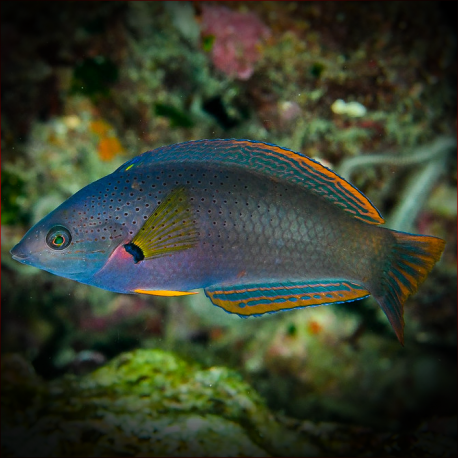More info
Datasheet
| Minimum Tank Size | 600 litres / 158.50 US gallons |
| Maximum Size | 18.0cm / 7.09inches |
| Reef Compatible | Reef safe with caution |
| Temperament | Mostly peaceful but might be aggressive towards similar species |
| Temperature | 22.2°C / 71.96°F - 25.6°C / 78.08°F |
| Specific Gravity | 1.020-1.025 |
| Carbonate Hardness | 8-12 |
| pH | 8.1-8.4 |
General Description:
The Orangefin wrasse, scientifically known as Halichoeres melanochir, is a notable member of the Labridae family, known for its attractive appearance and efficacy in eliminating flatworms and pyramid snails in aquariums.
Aquarium Suitability:
Considered suitable for aquariums, the Orangefin wrasse should be chosen carefully, as it can be a threat to small crustaceans like shrimp and has a tendency to jump out of open aquaria.
Demands:
With average hardiness, this species requires a minimum tank size of 600 liters and a deep sandy substrate of at least 5 cm for burrowing.
Care and Hardiness:
Despite being mostly peaceful, the Orangefin wrasse can exhibit aggression towards similar species if not given adequate space. It is important to ensure they are not injured during transportation, as they are sensitive during this process.
Reef Suitability:
Reef safe with caution, the Orangefin wrasse can be kept in reef aquariums but should be monitored closely.
Aquarium Setup:
When setting up the aquarium for an Orangefin wrasse, it is crucial to provide a deep sandy substrate for burrowing and ensure there is enough space for them to roam. Monitoring aggression towards similar species is advisable.
Behaviour:
These wrasses have a unique behavior of digging themselves into the sand when threatened or needing to sleep. They also have an excellent biological clock, although it may take some time to adjust after transportation.
Feeding and Diet:
Feeding on small crustaceans like krill, mysis, and artemia, as well as zooplankton such as Cyclops and pods, the Orangefin wrasse has a varied diet that should be replicated in captivity.
Dimorphism:
The Orangefin wrasse is hermaphroditic, with the ability to change gender from female to male as needed.
Habitat and Distribution:
Found in the Western Pacific region, ranging from the Philippines to Taiwan and southern Japan, down to northwest Australia, the Orangefin wrasse inhabits a wide geographic area with varied environmental conditions.

